Wearable devices for real-time health tracking provide users with continuous monitoring of vital signs, enabling proactive health management. These devices utilize advanced sensors to track metrics like heart rate and sleep patterns. Integration with mobile applications allows for personalized health insights and goal setting. Challenges such as data accuracy and battery life remain, but innovations are enhancing user experience and engagement.
![]()
What are the key functionalities of wearable devices for health tracking?
Wearable devices for health tracking offer key functionalities such as real-time monitoring, data analysis, and personalized health insights. They track vital signs, activity levels, and sleep patterns, enabling users to manage their health proactively.
These devices typically include sensors for heart rate, blood pressure, and oxygen saturation, providing valuable data for health assessments. Advanced models may also feature ECG monitoring and stress level analysis, enhancing their utility.
Interconnectivity with mobile applications allows users to visualize their health data, set goals, and receive tailored feedback. This integration fosters greater engagement with personal health management.
The ability to sync with other health platforms and share data with healthcare providers adds a layer of support, promoting comprehensive care and informed decision-making.
How do these devices monitor vital signs in real-time?
Wearable devices monitor vital signs in real-time using sensors that track physiological parameters. These sensors measure heart rate, blood pressure, oxygen saturation, and body temperature continuously. Data is transmitted to connected devices for analysis, enabling immediate feedback and health insights. Advanced algorithms enhance accuracy by filtering noise and identifying trends, making it easier for users to manage their health.
What types of data do wearable devices collect?
Wearable devices collect various types of data to monitor health and fitness. Key data types include heart rate, step count, sleep patterns, and calories burned. Additional metrics may include blood oxygen levels, body temperature, and activity type. These devices utilize sensors to provide real-time insights into user health, enhancing personal wellness management.
How do wearable devices integrate with mobile applications?
Wearable devices seamlessly integrate with mobile applications to provide real-time health tracking and data analysis. These devices collect biometric data, such as heart rate and activity levels, which mobile apps process and display. This integration enhances user experience by enabling personalized insights and actionable feedback. As a result, users can monitor their health metrics effectively and make informed decisions about their wellness. The unique attribute of this integration is the ability to sync data continuously, ensuring up-to-date information for users.
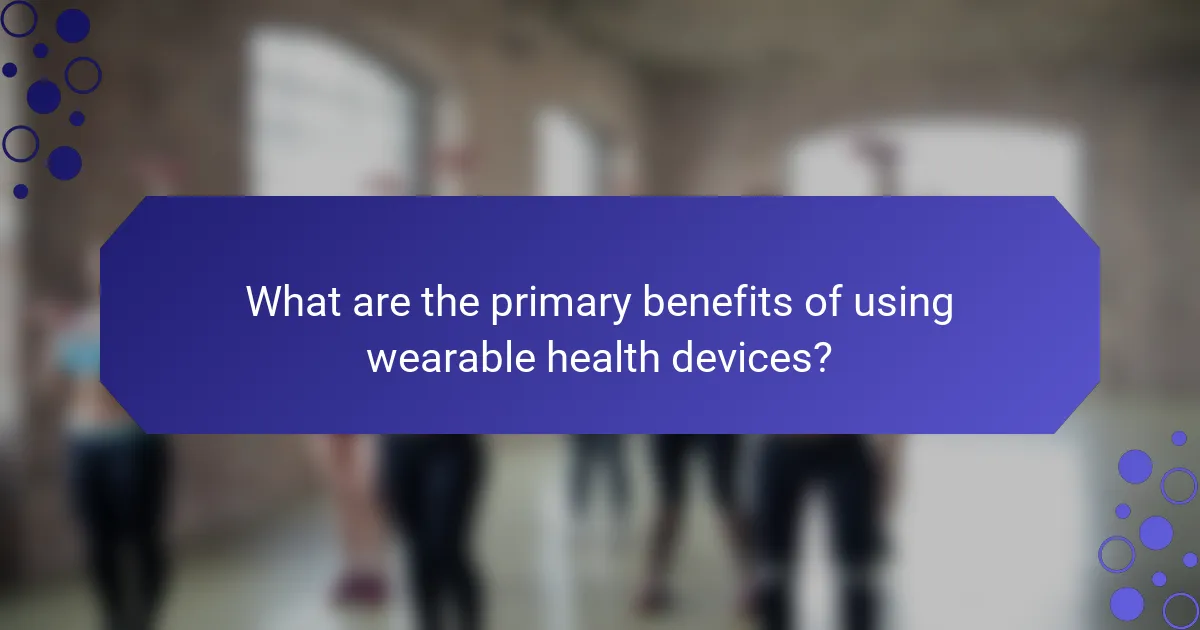
What are the primary benefits of using wearable health devices?
Wearable health devices offer numerous benefits, enhancing personal health management. They provide real-time tracking of vital signs, enabling users to monitor heart rate, activity levels, and sleep patterns. This data analysis helps in identifying health trends and potential issues early.
Furthermore, wearable devices promote accountability and motivation by setting fitness goals and tracking progress. They often include features like reminders for physical activity and hydration, fostering healthier habits.
Another key advantage is the integration with mobile applications, allowing users to visualize their health data and share it with healthcare providers. This connectivity can lead to personalized health recommendations and improved outcomes.
Overall, wearable health devices empower individuals to take charge of their health through continuous monitoring and actionable insights.
How can they enhance personal health management?
Wearable devices enhance personal health management by providing real-time health tracking and data analysis. These devices monitor vital signs like heart rate, sleep patterns, and physical activity, enabling users to make informed health decisions.
The integration of data analytics allows users to identify trends and adjust their lifestyle accordingly. For instance, a fitness tracker can reveal patterns in activity levels, encouraging more consistent exercise habits.
Moreover, some devices offer personalized feedback and recommendations, enhancing user engagement and motivation. This tailored approach can lead to improved health outcomes over time.
In summary, wearable devices serve as valuable tools for proactive health management, empowering individuals to take charge of their well-being through continuous monitoring and data-driven insights.
What role do they play in preventive healthcare?
Wearable devices play a crucial role in preventive healthcare by enabling continuous health monitoring and data analysis. They provide real-time insights into vital signs, activity levels, and sleep patterns, allowing users to identify potential health issues early. For example, a smartwatch can track heart rate variability, which may indicate stress or cardiovascular concerns. This proactive approach empowers individuals to make informed lifestyle choices, ultimately reducing the risk of chronic diseases.
How do they support chronic disease management?
Wearable devices support chronic disease management by providing real-time health tracking and data analysis. They enable continuous monitoring of vital signs, which helps patients and healthcare providers make informed decisions. These devices can track metrics such as heart rate, blood glucose levels, and physical activity, allowing for timely interventions.
Additionally, wearables often integrate with mobile applications, facilitating data sharing with healthcare professionals. This connectivity enhances communication and ensures that treatment plans are adjusted based on up-to-date information. The ability to set reminders for medication adherence further supports patients in managing their conditions effectively.
Overall, wearable devices empower individuals to take control of their health, leading to improved outcomes in chronic disease management.
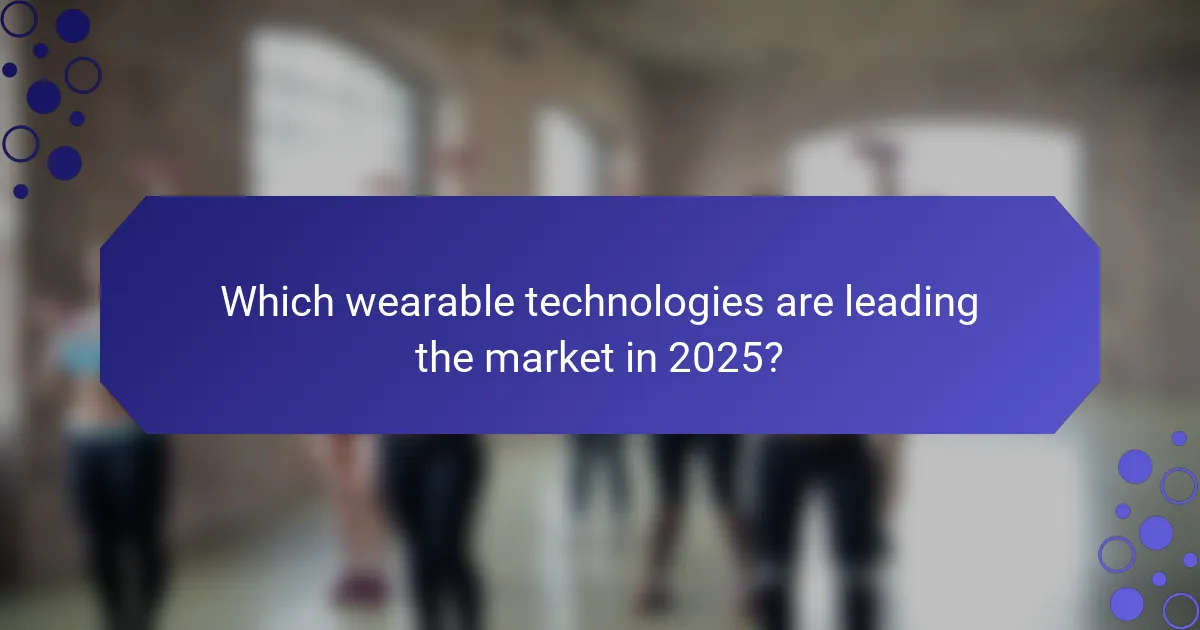
Which wearable technologies are leading the market in 2025?
Wearable devices for real-time health tracking and data analysis in 2025 will be led by smartwatches, fitness trackers, and health monitoring patches. These technologies will prioritize advanced biometric sensors, enhanced battery life, and seamless data integration.
Smartwatches like the Apple Watch Series 9 and Samsung Galaxy Watch 6 will dominate due to their comprehensive health features, including ECG and blood oxygen monitoring. Fitness trackers such as Fitbit Charge 6 will focus on activity tracking and sleep analysis, appealing to health-conscious consumers. Health monitoring patches will emerge as innovative solutions for continuous health data collection, offering convenience and accuracy.
The market will also see advancements in AI-driven analytics, enabling personalized health insights. This capability will allow users to make informed decisions about their health and wellness. As a result, these wearable technologies will play a crucial role in preventive healthcare and chronic disease management.
What differentiates smartwatches from fitness trackers?
Smartwatches typically offer more advanced features than fitness trackers, including app support and notifications. Smartwatches focus on multifunctionality, while fitness trackers specialize in health metrics like heart rate and steps. Smartwatches often have larger displays, enabling better interaction. Fitness trackers generally prioritize battery life, lasting longer on a single charge.
How do specialized devices like continuous glucose monitors function?
Specialized devices like continuous glucose monitors function by continuously measuring glucose levels in the interstitial fluid. These devices utilize sensors that detect changes in glucose concentration, providing real-time data to users.
The data collected is transmitted to a smartphone or a dedicated display, allowing users to track their glucose levels throughout the day. Continuous glucose monitors can alert users to high or low glucose levels, enabling timely interventions.
These devices often feature customizable alerts and trends analysis, enhancing diabetes management. Unique attributes include their ability to function without fingerstick blood tests, significantly improving user experience and comfort.
What emerging technologies are influencing wearable health devices?
Emerging technologies such as artificial intelligence, machine learning, and advanced sensors are significantly influencing wearable health devices. These innovations enhance real-time health tracking and data analysis, providing users with personalized insights and predictive health management. AI algorithms improve data accuracy and enable advanced analytics, while new sensor technologies monitor vital signs with greater precision. Additionally, the integration of cloud computing facilitates seamless data sharing and storage, enhancing user experience and accessibility.
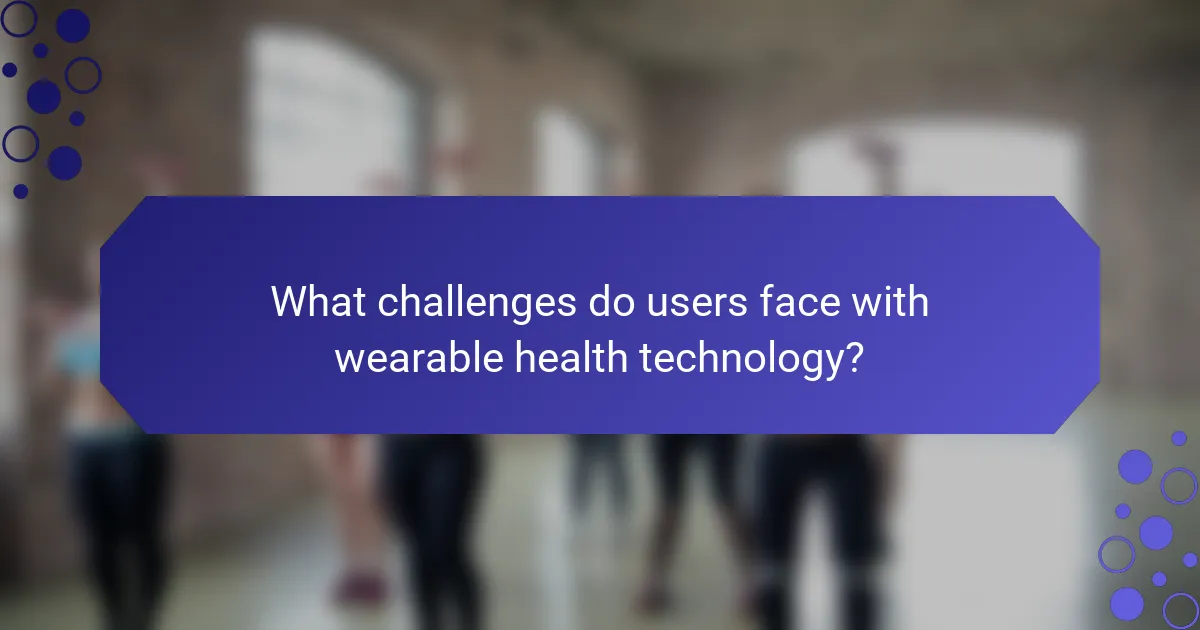
What challenges do users face with wearable health technology?
Users face several challenges with wearable health technology, including data accuracy, battery life, and user interface complexity. Data accuracy issues can lead to unreliable health insights, impacting user trust. Many devices have limited battery life, requiring frequent recharging, which can disrupt usage. Additionally, complex interfaces may deter users from fully utilizing features, reducing overall effectiveness. Compatibility with other devices and platforms can also pose challenges, hindering seamless integration and data sharing.
How do privacy concerns affect user adoption?
Privacy concerns significantly hinder user adoption of wearable devices for real-time health tracking. Users prioritize data security and worry about unauthorized access to sensitive health information. Companies must address these concerns with transparent privacy policies and robust data protection measures. A survey revealed that 60% of potential users hesitate due to privacy issues. Ensuring compliance with regulations like GDPR can enhance trust and encourage wider acceptance of these technologies.
What are the common technical limitations of these devices?
Wearable devices for real-time health tracking face several common technical limitations. These include battery life constraints, limited data storage, connectivity issues, sensor accuracy, user interface challenges, and compatibility with other devices.
Battery life typically lasts between 24 to 48 hours, necessitating frequent recharging. Limited data storage restricts the amount of health information that can be retained. Connectivity issues may arise due to reliance on Bluetooth or Wi-Fi, affecting data transfer. Sensor accuracy can vary, leading to unreliable health metrics. User interface challenges may hinder usability, especially for older adults. Compatibility with various operating systems can limit the device’s functionality.
How can users overcome data accuracy issues?
Users can overcome data accuracy issues by ensuring proper calibration and regular maintenance of wearable devices. Accurate data relies on correct device settings and user compliance with usage guidelines.
Additionally, users should monitor their devices for software updates, as these can improve data collection algorithms. Engaging with community forums can also provide insights into common issues and solutions, enhancing overall device performance.
Lastly, integrating multiple data sources can validate readings, allowing users to cross-reference information for improved accuracy.
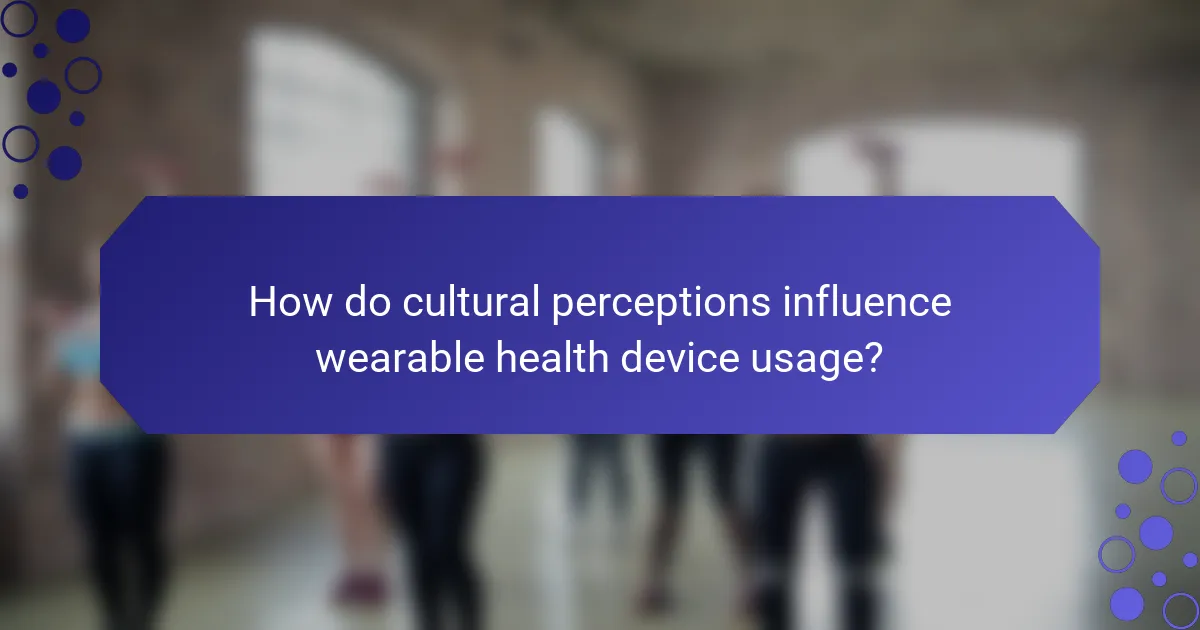
How do cultural perceptions influence wearable health device usage?
Cultural perceptions significantly influence the usage of wearable health devices. Different cultures prioritize health and technology in unique ways, affecting adoption rates and engagement levels.
For instance, in tech-savvy cultures, wearables are often embraced for their data analysis capabilities, while in others, skepticism towards technology may hinder usage. Additionally, cultural beliefs about health and wellness can shape how individuals perceive the benefits of real-time health tracking.
Studies show that in cultures with a strong emphasis on preventive healthcare, wearables are more likely to be integrated into daily routines. Conversely, cultures that prioritize traditional health practices may view these devices as unnecessary.
Ultimately, understanding cultural context is essential for manufacturers aiming to enhance user experience and promote wider acceptance of wearable health technology.
What factors affect user engagement in different regions?
User engagement in different regions is influenced by cultural attitudes, technology access, and health awareness. Cultural attitudes shape how individuals perceive health tracking, impacting their willingness to adopt wearable devices. Regions with high technology access see greater usage due to better connectivity and device availability. Health awareness levels also determine engagement, as informed users are more likely to utilize real-time health data for personal benefits.
How does societal attitude towards health technology vary?
Societal attitudes towards health technology, particularly wearable devices for real-time health tracking, vary significantly. Acceptance often hinges on perceived benefits, such as improved health management and preventive care. In regions with higher health awareness, users embrace these technologies, valuing data-driven insights. Conversely, skepticism exists in areas where privacy concerns dominate, leading to hesitance in adopting such devices. Cultural norms also play a role; for instance, communities prioritizing traditional healthcare may resist technological integration. Overall, the perception of wearable devices is shaped by a blend of benefits, privacy issues, and cultural values.
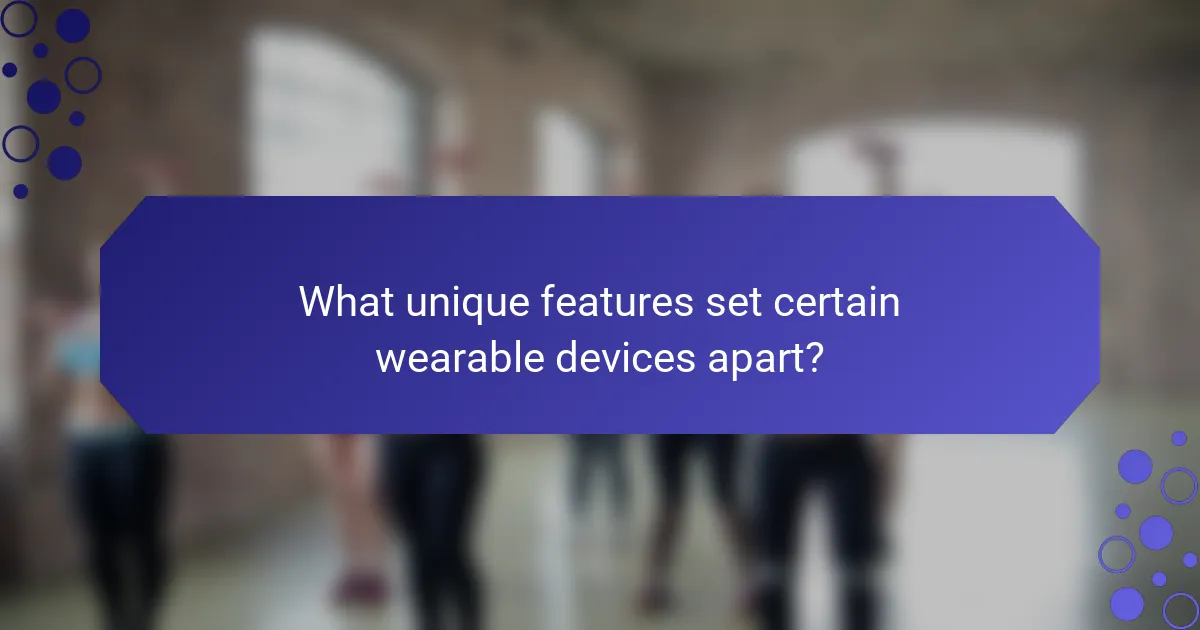
What unique features set certain wearable devices apart?
Certain wearable devices stand out due to features like advanced biometric sensors, customizable interfaces, and prolonged battery life. These attributes enhance user experience and data accuracy. For instance, some devices offer ECG monitoring, providing unique health insights. Additionally, integration with health apps allows for real-time data analysis, making these wearables essential for proactive health management.
How does battery life impact user experience?
Battery life significantly influences user experience with wearable devices. Users expect devices to provide continuous health tracking without frequent recharging. A longer battery life enhances usability, allowing for uninterrupted data collection and analysis. For instance, a device with a battery life of 7 days compared to one with 2 days supports more extensive tracking of health metrics. This reliability fosters user trust and satisfaction, essential for maintaining engagement with health technology.
What innovative designs are emerging in the wearable market?
Innovative designs in the wearable market focus on advanced health tracking and data analysis. These devices now feature integrated sensors for continuous monitoring of vital signs, offering real-time feedback. Smartwatches and fitness trackers are incorporating AI algorithms to analyze health data, providing personalized insights. Emerging designs also emphasize comfort and aesthetics, with flexible materials and customizable interfaces enhancing user experience. Additionally, some wearables now support seamless connectivity with other smart devices, creating a holistic health management ecosystem.
How do customization options enhance user satisfaction?
Customization options significantly enhance user satisfaction by allowing individuals to tailor wearable devices to their specific health needs and preferences. Personalized settings enable users to track metrics that matter most to them, such as heart rate, sleep patterns, and activity levels. This adaptability fosters a sense of ownership and engagement, making users more likely to adhere to their health goals. Additionally, customizable alerts and reminders ensure that users receive timely notifications, further improving their overall experience with the device.
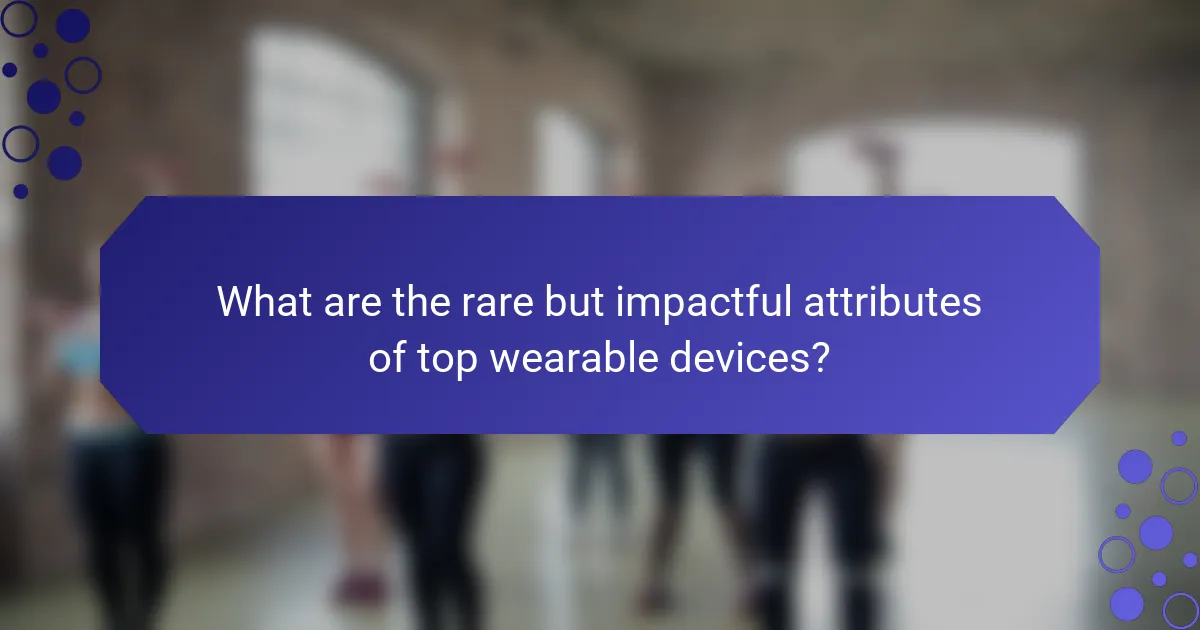
What are the rare but impactful attributes of top wearable devices?
Top wearable devices have rare but impactful attributes that enhance health tracking. These include advanced biometric sensors, which measure unique metrics like hydration levels, and AI-driven analytics that provide personalized health insights. Additionally, some devices feature long-range connectivity, allowing data sharing with healthcare providers in real time. Another rare attribute is the integration of stress management tools, which offer real-time feedback on mental well-being. These attributes significantly improve user engagement and health outcomes.
How do specific algorithms enhance data analysis accuracy?
Specific algorithms enhance data analysis accuracy in wearable devices by applying advanced statistical techniques and machine learning models. These algorithms process real-time health data, improving precision in metrics like heart rate and activity levels. For example, algorithms can filter noise from physiological signals, ensuring reliable readings. Additionally, predictive analytics can forecast health trends, enabling proactive interventions. This integration of algorithms transforms raw data into actionable insights, ultimately supporting better health outcomes.
What unique partnerships are shaping the future of wearable health tech?
Collaborations between tech companies, healthcare providers, and research institutions are revolutionizing wearable health tech. Notable partnerships include Apple with health organizations for data sharing and Fitbit with hospitals for patient monitoring. These alliances enhance device functionality and improve patient outcomes. Unique attributes like real-time data analytics and personalized health insights are becoming standard, shaping the future of health management. As a result, users benefit from more accurate health tracking and tailored health solutions.
How do wearable devices support mental health tracking?
Wearable devices enhance mental health tracking by providing real-time data on physiological and psychological states. They monitor metrics like heart rate variability, sleep patterns, and physical activity, which correlate with mental well-being. These devices can offer insights into stress levels and mood fluctuations, enabling users to identify triggers and patterns. As a result, individuals can make informed lifestyle adjustments to support their mental health.
What best practices can users adopt for maximizing wearable device benefits?
To maximize the benefits of wearable devices, users should adopt consistent tracking habits, set clear health goals, and engage with data insights. Regularly updating device software enhances functionality. Users should also explore community features for motivation and support. Prioritizing battery management extends device usability.